Summary
Revista Brasileira de Ginecologia e Obstetrícia. 2007;29(11):568-574
DOI 10.1590/S0100-72032007001100004
PURPOSE: to evaluate the histological differentiation pattern in superficial peritoneum lesions and in deeply infiltrating endometriosis (DIE) in utero-sacral ligament, bowel (rectum and sigmoid colon) and rectovaginal septum. METHODS: this prospective non-randomized study included 139 patients. Of the total, 234 biopsies were obtained (179 with DIE - Deeply Group - and 55 superficial endometriosis - Superficial Group). From the 179 DIE lesions (Depply Group), 15 were obtained from rectovaginal septum, 72 from rectosigmoid nodules and 92 from utero-sacral ligament. Biopsies were classified in well-differentiated glandular pattern, undifferentiated glandular, mixed glandular differentiation and pure stromal disease, based on specific morphological classification. RESULTS: in the Depply Group (DIE), 33.5% of the biopsies showed undifferentiated glandular pattern and 46.9% mixed glandular pattern. In the Superficial Group, there was the predominance of the well-differentiated glandular pattern (41.8%). Comparing specifically the different localizations of the biopsies of DIE lesions (Deeply Group), a predominance of mixed pattern in bowel nodules (61.1%) was noted. CONCLUSIONS: it was possible to conclude that there is a predominance of well-differentiated glandular pattern in superficial endometriosis, a predominance of mixed undifferentiated in deeply pelvic endometriosis and, specifically studying endometriosis from the rectum and sigmoid colon, there was a predominance of the mixed pattern.
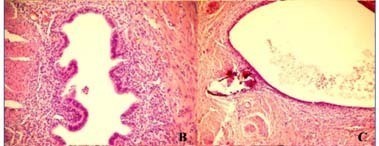
Summary
Revista Brasileira de Ginecologia e Obstetrícia. 2012;34(12):568-574
DOI 10.1590/S0100-72032012001200007
PURPOSE: To evaluate the expression of neurotrophic (NGF, NPY and VIP) and pro-inflammatory (TNF-α) mediators in the rectum and sigmoid fragments compromised by endometriosis. METHODS: Twenty-four patients were selected to undergo surgical treatment of endometriosis of the rectum and sigmoid colon with a segmental resection technique, followed by end-to-end anastomosis with a circular stapler from January 2005 to December 2007. The study included premenopausal women who underwent surgical treatment for deep endometriosis infiltrating the rectum with involvement of the rectum and sigmoid, reaching the level of the muscle layer, submucosa or mucosa. Twenty-four rectum and sigmoid fragments with histologically confirmed endometriosis, one from each of the 24 selected patients, were used for the study group. For the control group, we used a fragment of the distal resection margin called anastomosis ring from each of the 24 patients enrolled in the study. Samples were grouped into Tissue Micro Array (TMA) blocks and subjected to immunohistochemistry to evaluate the expression of tumor necrosis factor alpha (TNF-α), nerve growth factor (NGF), neuropeptide Y (NPY) and P vasoactive intestinal peptide (VIP), followed by semiquantitative analysis of immunostaining by reading the relative optical density (OD). RESULTS: There was higher optical density relative to TNF-α immunostaining and NGF in the study group (samples with intestinal endometriosis), DO=0.01, for the two proteins, respectively (p<0.05), compared to controls without endometriosis. There was no statistically significant difference in the optical density of immunostaining of NPY and VIP. CONCLUSION: We identified increased immunostaining of TNF-α antibodies and fragments of NGF in the rectum and sigmoid compromised by endometriosis compared to disease-free controls. We did not identify any statistical difference in immunostaining of NPY and VIP proteins.
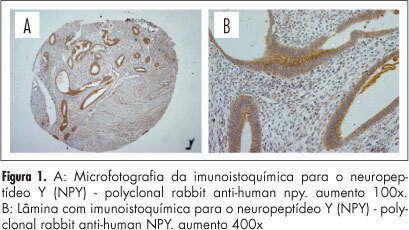
Summary
Revista Brasileira de Ginecologia e Obstetrícia. 2013;35(12):569-574
DOI 10.1590/S0100-72032013001200007
PURPOSE: This study aimed to evaluate the frequency of homozygous deletion of GSTM1 and GSTT1 genes and their combinations between patients with breast cancer and healthy individuals, associating them with disease susceptibility. METHODS: This is a case-control study in which 49 women diagnosed with breast cancer confirmed by pathological examination and 49 healthy women with no evidence of cancer and no prior family history of breast cancer were invited to participate. All of them answered a questionnaire with epidemiological data and were submitted to blood sample collection. Genomic DNA was extracted from blood, and genotyping was performed by polymerase chain reaction. Data were analyzed with SPSS 20.0. RESULTS: The frequency of null alleles for GSTM1 and GSTT1 was 58.8 and 61.7%, respectively, for patients with breast cancer, and 41.2 and 38.3%, respectively, in control patients. In homozygous deletion of the GSTM1 gene, a significantly higher frequency was found in the breast cancer cases. CONCLUSION: Breast cancer patients presented higher frequency of homozygous deletion of the GSTM1 gene compared with the control group.
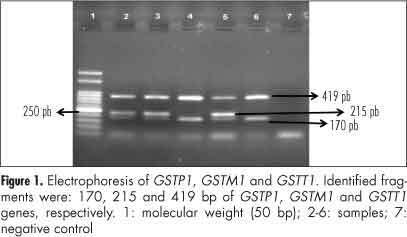
Summary
Revista Brasileira de Ginecologia e Obstetrícia. 2020;42(9):569-576
To performa comprehensive review to provide practical recommendations regarding the diagnosis and treatment of benign adnexal masses, as well as information for appropriate consent, regarding possible loss of the ovarian reserve.
A comprehensive review of the literature was performed to identify the most relevant data about this subject.
In total, 48 studies addressed the necessary aspects of the review, and we described their epidemiology, diagnoses, treatment options with detailed techniques, and perspectives regarding future fertility.
Adnexal masses are extremely common. The application of diagnosis algorithms is mandatory to exclude malignancy. A great number of cases can bemanaged with surveillance. Surgery, when necessary, should be performed with adequate techniques. However, even in the hands of experienced surgeons, there is a significant decrease in ovarian reserves, especially in cases of endometriomas. There is an evident necessity of studies that focus on the long-term impact on fertility.
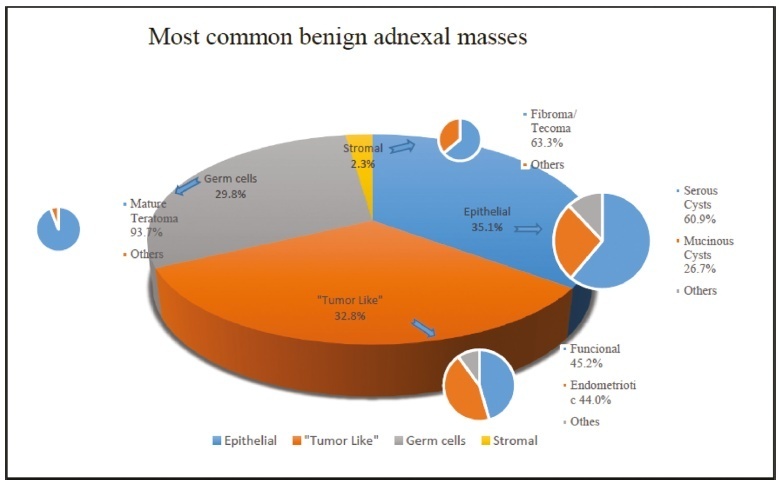
Summary
Revista Brasileira de Ginecologia e Obstetrícia. 1999;21(10):569-576
DOI 10.1590/S0100-72031999001000002
Purpose: to estimate growth curves and tables of average biparietal diameter and average head circumference of twin gestations and to compare them with published growth curves for singletons and twins. Methods: growth curves and tables of average biparietal diameter and average head circumference were obtained from sonographic examinations of 34 patients with twin gestations without maternal and fetal complications. Sonographic examinations were performed each 2 or 3 weeks by a single observer. The parameters were compared with existing growth curves for singletons and twins. Results: curves and tables of biparietal diameter and head circumference in relation to gestational age were obtained. The study revealed difference in growth pattern mainly regarding the 3rd trimester in relation to singletons (Hadlock et al.15). The difference between the average values were 6 mm (biparietal diameter) and 2.0 cm (head circumference) at the 39th week of gestation. Also, some differences were observed relative to the twin studies. Conclusion: this study revealed that growth curves for average biparietal diameter and average head circumference of singletons are not appropriate to determine gestational age in twin gestations of the studiced population principally at the 3rd trimester
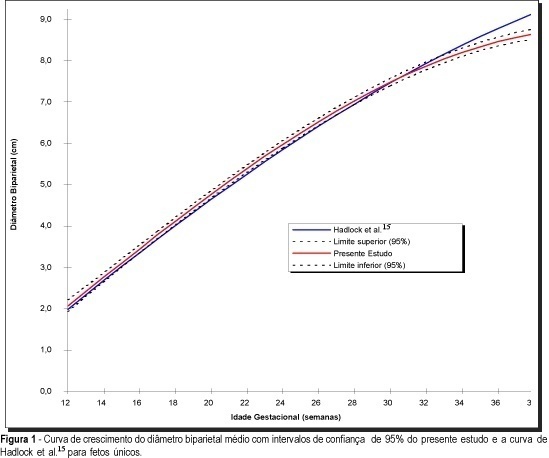
Summary
Revista Brasileira de Ginecologia e Obstetrícia. 2014;36(12):569-574
DOI 10.1590/SO100-720320140005068
The aim of this study was to evaluate the clinical features and prognostic implications of patients with recurrent cervical cancer.
By reviewing the medical records we evaluated all patients with cervical cancer at stages IA to IVA who started treatment at a specialized hospital in the Southeast region of Brazil from 2007 to 2009. Recurrence episodes were categorized according to location of disease and information was collected regarding the type of treatment and survival of these patients. The sample was characterized by descriptive statistics and association analyses were performed using Fisher's exact test.
Fifty cases of recurrence were identified among 469 selected records, with 31 patients being symptomatic at diagnosis of recurrence (62%); and 19 being asymptomatic (38%). Among women with symptoms, eight requested anticipation of the previously scheduled appointment because of the presence of clinical complaints. Patients with symptoms at the diagnosis of recurrence had lower rates of overall two-year survival (39.4 versus 67.6%) (p=0.081). None of the patients with recurrence at distance received curative intent treatment, but all received surgical treatment or radiotherapy aiming at full remission of the disease. Women who requested anticipation of the appointment because of the presence of symptoms had a significant reduction of overall two-year survival after recurrence (0 versus 60.4%; p<0.001) compared to those who attended the consultation on the scheduled date, and none of them received curative intent treatment. As expected, the patients who underwent palliative treatment with the main objective of improving quality of life and increasing survival but with no perspective of cure had a significant reduction in overall survival compared to those who were treated with curative intent (76.7 versus 35.4%; p<0.001).
The benefit of detecting asymptomatic recurrence of cervical cancer has the potential to improve the prognosis of patients with local and regional recurrence, but studies on larger series are necessary to confirm this possibility.
Summary
Revista Brasileira de Ginecologia e Obstetrícia. 2017;39(10):569-575
Summary
Revista Brasileira de Ginecologia e Obstetrícia. 2018;40(2):57-58